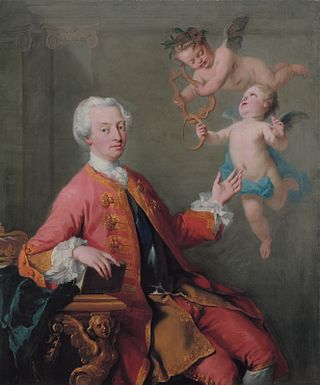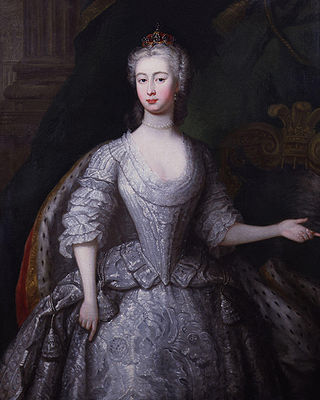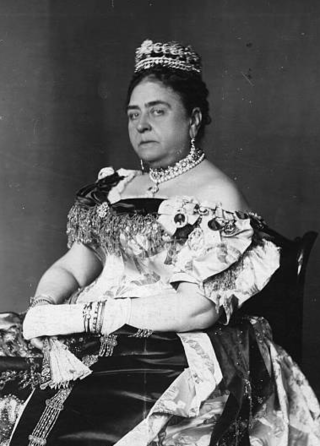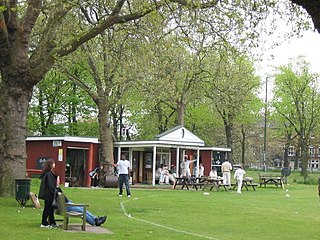Related Research Articles

George II was King of Great Britain and Ireland, Duke of Brunswick-Lüneburg (Hanover) and a prince-elector of the Holy Roman Empire from 11 June 1727 (O.S.) until his death in 1760.
The British royal family comprises King Charles III and his close relations. There is no strict legal or formal definition of who is or is not a member, although the Royal Household has issued different lists outlining who is a part of the royal family. Members often support the monarch in undertaking public engagements, and pursue charitable work and interests. Members of the royal family are regarded as British and world cultural icons.

Caroline of Brandenburg-Ansbach was Queen of Great Britain and Ireland and Electress of Hanover from 11 June 1727 until her death in 1737 as the wife of King George II.

Frederick, Prince of Wales was the eldest son and heir apparent of King George II of Great Britain. He grew estranged from his parents, King George and Queen Caroline. Frederick was the father of King George III.

Kew is a district in the London Borough of Richmond upon Thames. Its population at the 2011 census was 11,436. Kew is the location of the Royal Botanic Gardens, now a World Heritage Site, which includes Kew Palace. Kew is also the home of important historical documents such as Domesday Book, which is held at The National Archives.

Princess Augusta of Saxe-Gotha-Altenburg was Princess of Wales by marriage to Frederick, Prince of Wales, eldest son and heir apparent of King George II. She never became queen consort, as Frederick predeceased his father in 1751. Augusta's eldest son succeeded her father-in-law as George III in 1760. After her spouse died, Augusta was the presumptive regent of Great Britain in the event of a regency, until her son reached majority in 1756.

James FitzJames Butler, 2nd Duke of Ormonde, (1665–1745) was an Irish statesman and soldier. He was the third of the Kilcash branch of the family to inherit the earldom of Ormond. Like his grandfather, the 1st Duke, he was raised as a Protestant, unlike his extended family who held to Roman Catholicism. He served in the campaign to put down the Monmouth Rebellion, in the Williamite War in Ireland, in the Nine Years' War and in the War of the Spanish Succession but was accused of treason and went into exile after the Jacobite rising of 1715.
Richmond is a town in south-west London, 8.2 miles (13.2 km) west-southwest of Charing Cross. It stands on the River Thames, and features many parks and open spaces, including Richmond Park, and many protected conservation areas, which include much of Richmond Hill. A specific Act of Parliament protects the scenic view of the River Thames from Richmond.

Princess Mary Adelaide of Cambridge, later known as the Duchess of Teck, was a member of the British royal family. She was one of the first royals to patronise a wide range of charities and was a first cousin of Queen Victoria.

Princess Amelia Sophia Eleonore of Great Britain was the second daughter of King George II of Great Britain and Queen Caroline. Born in Hanover, she moved to England when her grandfather George I became king. Amelia lived a solitary existence and died in 1786, the last surviving child of her parents.

Kew Palace is a British royal palace within the grounds of Kew Gardens on the banks of the River Thames. Originally a large complex, few elements of it survive. Dating to 1631 but built atop the undercroft of an earlier building, the main survivor is known as the Dutch House. Its royal occupation lasted from around 1728 until 1818, with a final short-lived occupation in 1844. The Dutch House is Grade I listed, and open to visitors. It is cared for by an independent charity, Historic Royal Palaces, which receives no funding from the government or the Crown. Alongside the Dutch House is a part of its 18th-century service wing, whilst nearby are a former housekeeper's cottage, brewhouse and kitchen block – most of these buildings are private, though the kitchens are open to the public. These kitchens, the Great Pagoda and Queen Charlotte's Cottage are also run by Historic Royal Palaces.

Bagshot Park is a royal residence located near Bagshot, a village 11 miles (18 km) south of Windsor. It is on Bagshot Heath, a 50-square-mile (130 km2) tract of formerly open land in Surrey and Berkshire. Bagshot Park occupies 51 acres (21 ha) within the designated area of Windsor Great Park.

Thatched House Lodge is a Grade II-listed building, dating from the 17th century, in Richmond Park in the London Borough of Richmond upon Thames in London, England. It was the home of British prime minister Sir Robert Walpole and, since 1963, has been a royal residence, being leased from the Crown Estate by Princess Alexandra, The Honourable Lady Ogilvy, and, until his death in 2004, her husband, Sir Angus Ogilvy.

White Lodge is a Grade I listed Georgian house situated in Richmond Park, in the London Borough of Richmond upon Thames. Formerly a royal residence, it now houses the Royal Ballet Lower School, instructing students aged 11–16.

Kew Green is a large open space in Kew in west London. Owned by the Crown Estate, it is leased to the London Borough of Richmond-upon-Thames. It is roughly triangular in shape, and its open grassland, framed with broadleaf trees, extends to about thirty acres. Kew Green is overlooked by a mixture of period townhouses, historic buildings and commercial establishments. Since the 1730s, Kew Green has been a venue for cricket matches.
Hortus Kewensis is a series of works cataloguing the plant species in cultivation at the Royal Botanic Gardens at Kew in the late 18th and early 19th centuries.

St Anne's Church, Kew, is a parish church in Kew in the London Borough of Richmond upon Thames. The building, which dates from 1714 and is Grade II* listed, forms the central focus of Kew Green. The raised churchyard, which is on three sides of the church, has two Grade II* listed monuments – the tombs of the artists Johan Zoffany and Thomas Gainsborough. The French Impressionist painter Camille Pissarro (1830–1903), who stayed in 1892 at 10 Kew Green, portrayed St Anne's in his painting Church at Kew (1892).

The Whig Split occurred between 1717 and 1720, when the governing British Whig Party divided into two factions: one in government, led by James Stanhope; the other in opposition, dominated by Robert Walpole. It coincided with a dispute between George I and his son George, Prince of Wales, with the latter siding with the opposition Whigs. It is also known as the Whig Schism. After three years it was resolved by a reconciliation between the two factions. Walpole went on to serve as Prime Minister from 1721 to 1742.

Cambridge Cottage is a former royal residence in Kew in London. It is located on the west side of Kew Green, very close to St Anne's Church; the rear of the house is in Kew Gardens, where it is known as the Duke's Garden. Historically it is associated with Prince Adolphus, Duke of Cambridge and his son Prince George, Duke of Cambridge, from whom it takes its name.
John Haverfield Sr (1694–1784) was an English gardener.
References
- ↑ "Richmond Gardens, Queen Caroline & English Landscape Gardening". Kew Royal Botanic Gardens. Archived from the original on 7 October 2012. Retrieved 16 August 2021.
- ↑ Desmond p.2
- ↑ Hammond p.38
- ↑ Brown p.323-24
- ↑ Black p.175

